.
Garden Diary - July 2024
All content included on this site such as text, graphics and images is protected by U.S and international copyright law.
The compilation of all content on this site is the exclusive property of the site copyright holder.
Flowers Around Town
in July 2024
It started in the days of covid-19. Everyone was told to sequester at home. For me, a difficult part of the restrictions meant I could no longer go to visit gardens. Very sad. To make me feel better, Paul would drive me around town to look for flowers in people's yards. I did my best to photograph out the car's window, with an occasional escape out the door for an image while huddled against the car. Now vaccinated (multiple times, in the years since) I am still watching for flowers in other gardens. But now I can comfortably get out of the car and even cross the street.
Thursday, 25 July
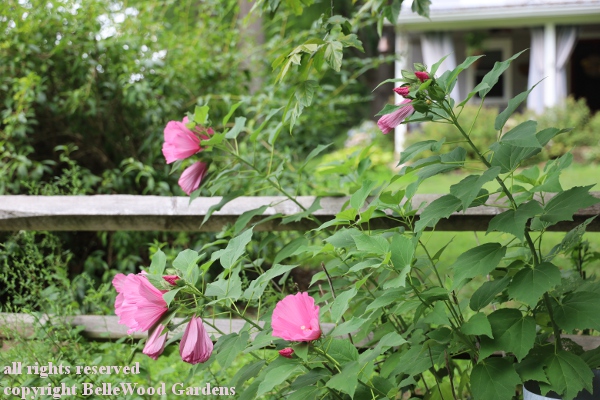
Rose of Sharon, Hibiscus syriacus, on Fairview Road in Kingwood Township. Native to Korea,
taken to Japan, then brought to Europe and North America. Hardier than expected. Not fussy,
easily grown. Propagate from seeds or if you find one you like, just propagate from cuttings.
Tuesday, 23 July
Blue dandelion, blue sailors, ragged sailors, coffeeweed, cornflower, wild bachelor's buttons, wild endive.

Chickory, Cichorium intybus, is showing its blue flowers along the roads all around here and there.

This "here" is along Milford Warren Glen Road in Holland Township. Much shorter than its potential height.
Chickory can survive in lawns due to its ability to resprout from its low basal rosette of leaves. Both a cultivated crop and a weedy plant, many varieties are cultivated for salad leaves. Roots of var. sativum are baked, ground, and used as a coffee substitute. The blanched buds of var. foliosum are sold as Belgian endive. Common names for other cultivars include endive, radicchio, radichett, French endive, red endive, sugarloaf, and witloof. So offer some respect for what might be thought of as a roadside weed. Until you buy it at a greengrocer, absent its pretty flowers.
Tuesday, 16 July 2024
It was in Flowers Around Town in June, on 20 June to be precise, that I wrote about European chestnut, Castanea sativa, in flower. Those were the showy, long, trailing catkins of male flowers. Slowing down as I drove past the tree today (fortunately no traffic behind me) I was just able to see
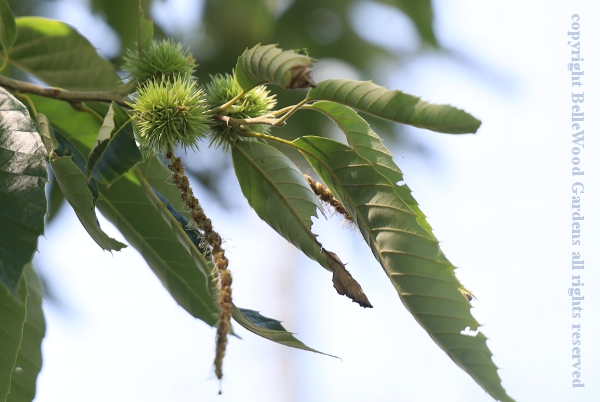
the spiky green globular female flowers, or possible immature chestnuts. The brown string
beneath them is the remnants of the male flowers. No idea how pollination is accomplished
as the sequence of male flowers in bloom, then female flowers are separated by a few weeks.
Sunday, 14 July

Crape myrtle or crepe myrtle. Both seem to be acceptable. Of course, there's always the Latin
Lagerstroemia indica. Popular in the South, thriving in hot summers, flowering on new wood
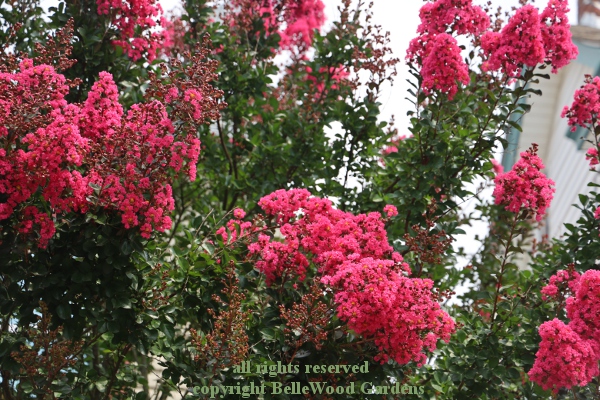
the trees are becoming popular even in Mid-Atlantic up to coastal Massachusetts. A lovely display
here on Second Street in Frenchtown, vivid cerise pink flowers after so many trees have finished.
A tangled mass of threads thrown around on Creek Road. No flowers, don't see any leaves.
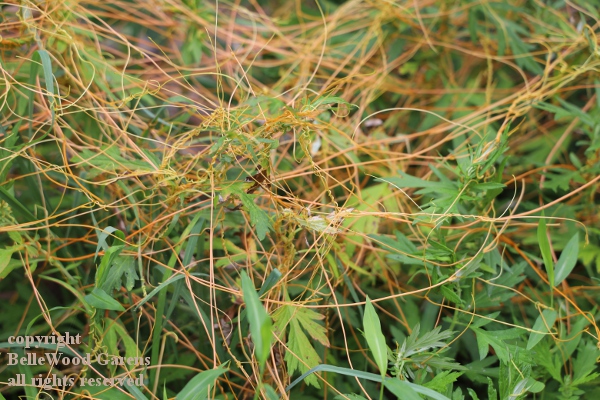
What is it? A parasitical plant called dodder. An annual, it germinates, then has just a few days
to sink hastoria into an adjacent green growing plant before the dodder's roots wither away.
It sucks nutrients from its host, flowers, makes seed, ready to repeat it all again the next year.
No wonder its other common names are strangleweed, devil's guts, hellbine, and witch's hair.
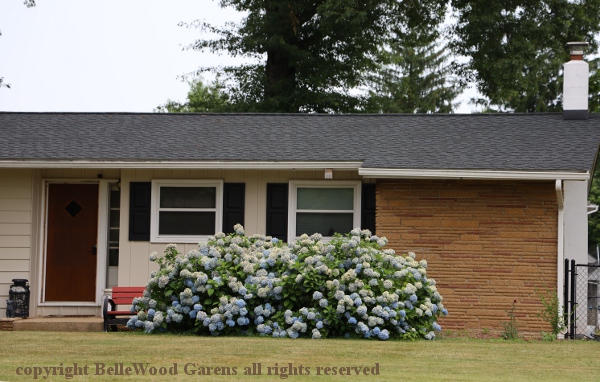
Color beginning to fade, some blue hydrangeas still looking lovely in a foundation planting on Route 519.
Friday, 12 July
It has been a splendid season for hydrangeas which have been in flower with billowing masses of sky blue mopheads in gardens around town. Due, it is thought, to last year’s weather. Abundant late-summer and fall rain resulted in excellent bud formation, and the exceptionally mild winter ensured that most, if not all, of those buds survived. While they do have an influence, it is not only soil pH levels and aluminum ion availability that control hydrangea flower color. There is an inherent genetic component that determines this.

I do like this hydrangea on Milford Road in Frenchtown. But I wonder
did the homeowners choose the shrub to go with the house, or was
it the other way around, choosing the paint to go with the hydrangea.
I've seen several so-called Persian silk tree, pink silk tree, or mimosa tree here and there along roads. Except either there's traffic behind me or barely a bicycle lane to the side. (And confusingly there's something completely different called mimosa. But that's neither here nor there.) Yesterday early evening as we were driving to the monthly township committee meeting I noticed a wonderful Albizia julibrissin. But didn't have my camera. Today we made a return outing so I might photograph. And here you can see the results.

A quite nice image of the albizia in wonderful bloom on Palmyra Corner Road
as it crosses Route 513. Very quick growing, also rather short lived. Seeds about.

Powderpuff of pink stamens. Popular with a diversity of insects, and hummingbirds.
Tuesday, 9 July
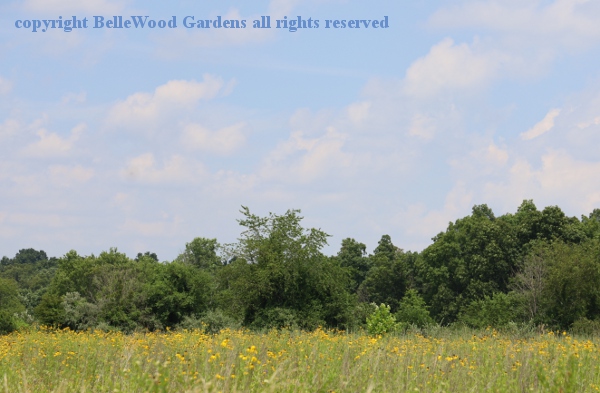
I noticed a haze of yellow as I was driving by this field on Route 519, suggesting a closer look.
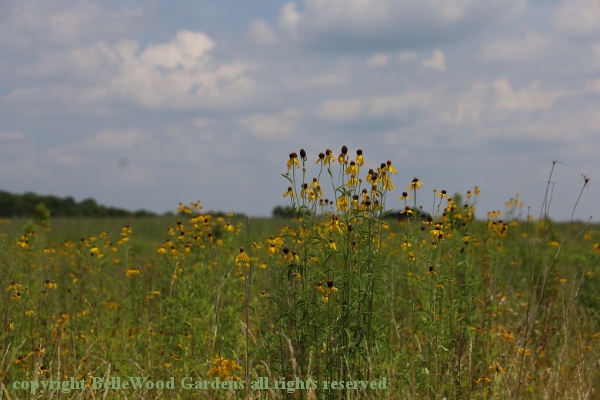
Another of the yellow daisies of summer, but clearly not black eyed Susan. Similar, but taller.
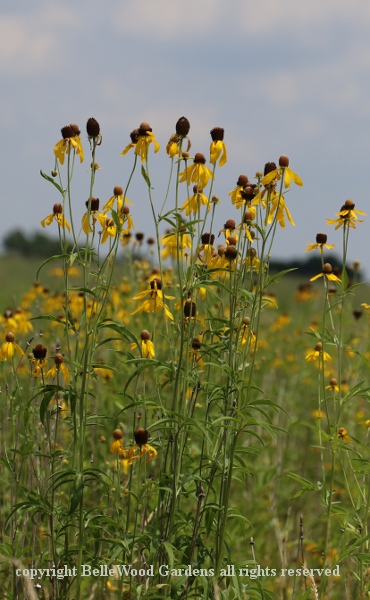
It is sweet coneflower, sweet black eyed Susan, Rudbeckia subtomentosa. Plants each have several branched flowering stalks. It is a native perennial found in states bordering the Mississippi River. No idea how it ended up in a field here in New Jersey, where it is growing quite happily.
Glad I stopped to see what was the source of the sunny color in this field.
Saturday, 6 July
 .
.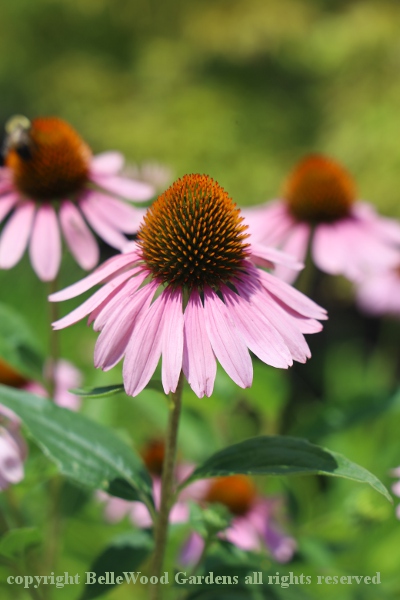
Prairie coneflower, Echinacea purpurea, at the Hunterdon County library on Route 12.
Yes, it is a native to much of the eastern, southeastern and midwestern United States.
Monday, 1 July

There is a sizeable grassy field on Route 12 between the Kingwood State Police barracks and Gaby's Cafe.
The edge towards the barracks shows some color. I asked, there's no problem, so I'm good to photograph.

There's milkweed, Asclepias syriaca. Some is already beginning to set their seedpods of silk.

A nice colony of black-eyed Susan, Rudbeckia hirta. They are annual or biennial, sometimes short lived perennial.
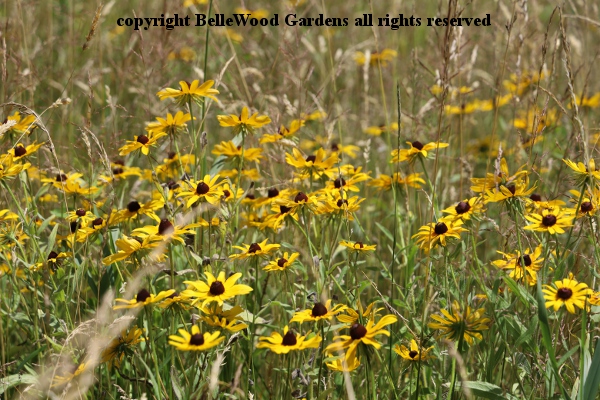
Hirta means hairy, from the trichomes, coarse hairs on both stems and leaves. Some sites mention
the plant is toxic to cats, causing vomiting if eaten. This might be due to the trichomes or little hairs.

The typical Asteraceae flowers are here made up of bright yellow ray florets that encircle
the conspicuous brown or black, dome-shaped cone made up of many small disc florets.
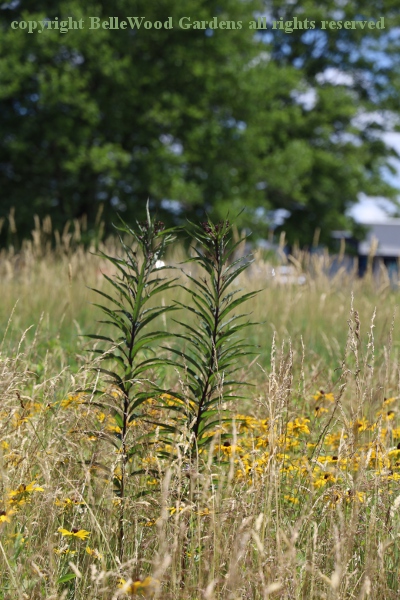
I'm fairly sure but not positive of the I.D. Didn't want to wade into the field. Ticks, you know. But it is probably New York ironweed, Vernonia novaboracensis. I'll keep an eye on it and if small bright violet-purple flowers appear, clustered at the top of the stems, that will be confirmation. As well as my camera perhaps I should also carry a pair of binoculars.
Back to July
Back to the main Diary Page














 .
.





